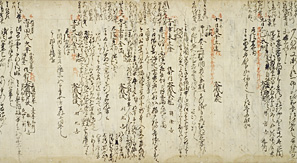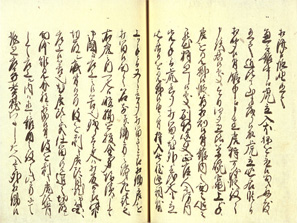These are the series of diaries written by Nakahara Moromori, an official who served the Imperial Government in the 14th century. He used margins and reverse sides of calendars in writing. His memorandums on military and social affairs of those days are the best information available today. Designated as an important cultural property in 2004.
Home > Important Cultural Properties
The NDL possesses the following six nationally-designated important cultural properties (introduced in chronological order by year of designation).
| Title | Data | Year of designation | No. |
|---|---|---|---|
| Tian tai shan ji (Tendaisan-ki) | written by Xu Lingfu (of Tang Dynasty, China), copied in the late Heian Period (11th to12th centuries), 1 book, 25.5 |
designated in 1955 | <WA1-2> |
| Mansai Jugo Nikki | written by Mansai (in his own handwriting), written from the 18th to 29th years of the Oei Era (1411 to 1422), 11 scrolls, 32.0cm in length | designated in 1956 | <WA1-1> |
| Xing jie (Seikai) | 3 volumes, edited by Shao Si (of Song Dynasty, China), printed in the Jing you Era (1034 to 1037), 3 books, 28.2 |
designated in 1956 | <WA1-3> |
| Meizukushi | copied in the 30th year of the Oei Era (1423), 1 book, 27.5 |
designated in 1968 | <WA1-4> |
| Moromori-ki | written by Nakahara no Moromori (in his own handwriting), written from the 2nd year of the Rekio Era to the 7th year of the Ouan Era (1339 to 1374), 64 scrolls, varied lengths from 27.0cm to 30.9cm | designated in 2004 | <WA1-5> |
| Soke-monjo: Tsushima-soke Wakan Kankei-shiryo | copied from the early Edo Period to the beginning of the Meiji Period (17th to19th centuries), 1,593 books | designated in 2007 | <WA1-6-1 |
In this special exhibition, we introduce "Moromori-ki" and "Soke-monjo" that have been recently designated as national important cultural properties.
76. Moromori ki
- written by Nakahara Moromori, a diary from 1339 to 1374, 64 scrolls, 27.0-30.9cm in length <WA1-5>
77. Soke monjo (Tsushima Soke wakan kankei shiryo)
- copied from the early Edo Period to the beginning of the Meiji Period, 1,593 books <WA1-6-1
 40>
40>
These documents were inherited within So family, a lord of Tsushima Island. This family was in charge of cultivating diplomatic and trade relationships with Korea, from the Muromachi Period to the Edo Period (1336 to 1867). The majority of the documents NDL possesses were archived at "Wakan" (a residential area for Japanese people) in Busan. These documents are important academic materials in studying the Japan-Korea relationship in the Edo periods. Designated as an important cultural property in 2007.






